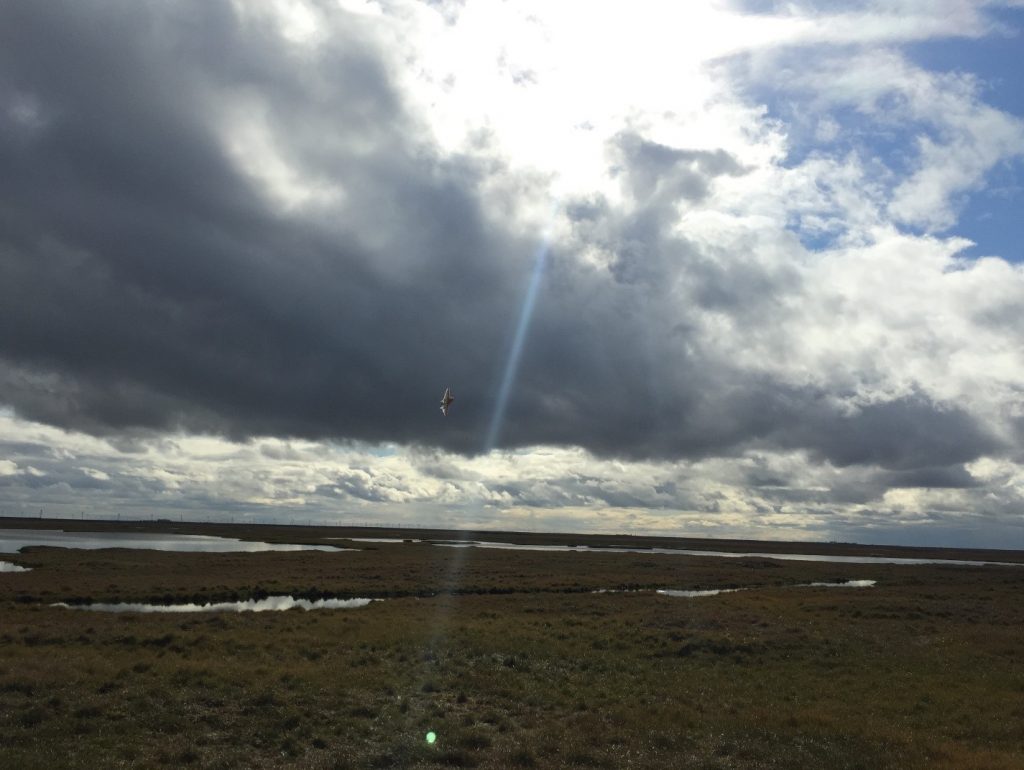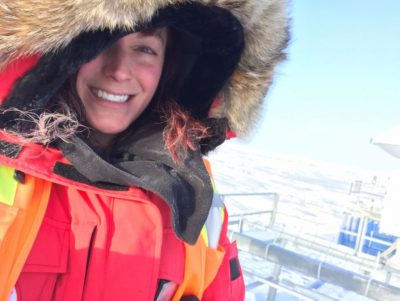A diverse team of atmospheric scientists goes to work in an evolving Arctic

Last spring, University of Colorado, Boulder research scientist Jessie Creamean spent a few weeks in frigid and windy Oliktok Point, Alaska. Within sight of the ice-bound Beaufort Sea and North Slope oil rigs and refineries, she set up an aerosol sampling system for a project on ice nucleating particles (INPs).
INPs are a poorly understood factor in arctic mixed-phase clouds, which play a significant role in controlling how much energy reaches the region’s vulnerable sea ice.
Creamean works at the Cooperative Institute for Research in Environmental Sciences (CIRES) and is part of a broadly skilled team of Boulder-based researchers at work on a four-year project designed to advance understanding of the arctic atmosphere.
It’s funded by the U.S. Department of Energy’s (DOE’s) Atmospheric System Research (ASR) program and led by another scientist at CIRES, principal investigator Gijs de Boer.
The project centers on Oliktok Point, a short-term atmospheric observatory funded by the DOE’s Atmospheric Radiation Measurement (ARM) Research Facility and home to the third ARM Mobile Facility (AMF3). It is about 260 kilometers (162 miles) southeast of Utqiaġvik (formerly known as Barrow), where ARM maintains its fixed North Slope of Alaska (NSA) atmospheric observatory.
The Right Skills
The entire ASR team is made up of physical scientists, but each has a diverse set of skills pushing the project ahead. Creamean, for one, specializes in aerosols (tiny cloud-forming particles in the air) and aerosol chemistry. De Boer, the ASR team lead for ARM efforts at Oliktok Point, is an expert in remote sensing and unmanned aerial systems (UAS)—the low-flying, slow-flying aircraft being promisingly tested as platforms for atmospheric observations.
Joining them in the Oliktok project are other experts from CIRES, each listed with an abbreviated hint of the expertise they bring: Matthew Shupe (cloud processes); Amy Solomon (large-eddy simulations and regional modeling); Christopher Cox (remote sensing and surface radiation budgets); Sergey Matrosov (scanning radars and precipitation properties); Christopher Williams (remote sensing, cloud dynamics, and microphysics); Maximilian Maahn (remote sensing, polar clouds); and doctoral student Matthew Norgren (aerosol-cloud interactions).

Joining the project group from the National Oceanic and Atmospheric Administration Earth System Research Laboratory in Boulder are Allison McComiskey (aerosol-cloud interactions) and Dave Turner (cloud evolution and longwave radiative transfer).
Arctic Missions
When the ASR project was launched in March 2015, it embraced an ambitious set of science questions related to fast-evolving conditions in the Arctic, where sea ice cover is shrinking, permafrost is warming, and ecosystems are changing.
These rapid changes are taking place within an atmospheric regime that has increasingly clear effects on weather in the lower altitudes and on earth systems at large.
De Boer and his collaborators have taken aim at knowledge gaps in some fundamental arctic atmospheric processes, with an eye to reducing uncertainties in the models designed to simulate present conditions and to predict future ones.
Together they have had a hand in 13 papers so far, either published or accepted.
“There is a lot more to be done,” says de Boer, noting a list of tasks on the whiteboard behind him. He hopes they will be addressed before the project closes out in February 2019.
Progress, in a Few Headlines
Broadly, the project has already shed light on the atmospheric influence of local industry near the site. It has also deployed new ways of measuring the atmosphere, including UAS and tethered balloons. “They provide perspectives we haven’t had in the past,” says de Boer.

The project has also added information on what de Boer calls “spatial variability.” Instead of Utqiaġvik being the only source of atmospheric data for that part of the Arctic, now there are two observatories from which to evaluate hypotheses.
The project’s official missions start with an investigation of the transitions between clear and cloudy atmospheric states in the high latitudes. “We’ve captured new information,” says de Boer. Novel simulations are underway.
Project investigators are also delving into high-latitude precipitation. In the Arctic, it is very hard to represent accurately the shape and mass of snowflakes, in part because it is hard to distinguish blowing snow from new snow. To address this difficulty, the team uses data from advanced instrumentation, including scanning cloud radars.
Much of the heavy lifting here comes from work on cloud microphysics by Matrosov, who uses scanning and longer wavelength radars to unravel precipitation properties, and by Solomon, an expert in using very high-resolution large-eddy simulations and regional modeling to understand key physical processes.
Before the Oliktok project very few data were archived about that sliver of the Arctic, says Shupe, a veteran of cold-weather campaigns. “We’ve gone from almost nothing coming out of there to having some important data products, studies, and papers.”
He pointed to studies by Maahn, Creamean, de Boer, Matrosov, and Williams (who did work on mathematically decluttering radar signals at the site, where the brightness of refinery pipelines is a confounder).
Shupe is also working with Turner to modify their Shupe-Turner algorithm for retrieving Arctic cloud properties (based on microphysical data from Utqiaġvik) to conditions at Oliktok. It will soon be released to the ARM Data Center.
Arctic Aerosols

The project also has a mission to characterize aerosols and the interactions between such particles and clouds. It is here that Creamean’s work, supported by ARM, takes on meaning. She is measuring INP freezing temperatures and concentrations at Oliktok Point, a research first.
During March 2017, and with help from site technicians who watched over her instruments through May, Creamean collected daily samples (dust, bacteria, and other particles) for a project that will soon yield a paper. Her questions: Where do these seeds for cloud droplets and ice crystals come from, and how do they impact the properties of arctic clouds?
The team is also exploring how aerosols scatter and absorb radiation in the atmosphere along Alaska’s North Slope; how such cloud-forming particles behave within seasonal cycles; and how different those particles are at Oliktok, within sight of oil fields, compared to the relatively pristine air of Utqiaġvik.
A 2017 paper, led by Maahn, looked at how cloud droplet sizes are affected by local industrial inputs at Oliktok.
The most ambitious task of the research team may be its investigation of arctic clouds and their climatological influence. In that region and elsewhere, clouds are one of the largest sources of uncertainty in models.
This summer will help on that score, when de Boer leads an ARM campaign he hopes will make Oliktok Point a central hub of activity during the Year of Polar Prediction (YOPP), an intensive period of coordinated international arctic observations.
De Boer says Profiles at Oliktok Point to Enhance YOPP Experiments (POPEYE), scheduled for July 1 through September 30, will add enhanced UAS, tethered balloon, and radiosonde (weather balloon) measurements to those already being collected by AMF3.
# # #
This work was supported by the U.S. Department of Energy’s Office of Science, Office of Biological and Environmental Research as part of the Atmospheric System Research Program.

